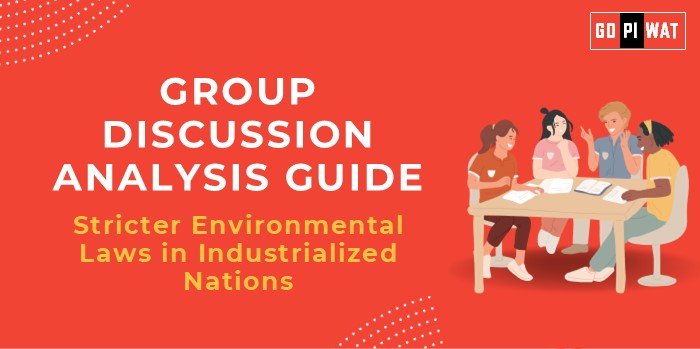📋 GROUP DISCUSSION (GD) ANALYSIS GUIDE
🌍 Stricter Environmental Laws in Industrialized Nations
🌟 Introduction to the Topic
Opening Context: “As industrialization accelerates global economic growth, its environmental toll raises pressing questions about sustainability and accountability.”
Background: The debate over stricter environmental laws stems from concerns about pollution, climate change, and resource depletion. Major industrialized nations are responsible for a significant share of global emissions and environmental degradation.
📊 Quick Facts and Key Statistics
- 🌍 Global CO₂ Emissions: Industrialized countries contribute approximately 45% of global emissions despite housing only 15% of the world population.
- 🌲 Deforestation Rates: Developed nations indirectly cause 31% of global deforestation via supply chain demands.
- 💸 Climate Change Costs: By 2050, environmental degradation could reduce global GDP by 10% (UNEP, 2023).
- 🔋 Renewable Energy Usage: Industrialized nations average 25% of total energy from renewables, while developing nations hover at 10%.
👥 Stakeholders and Their Roles
- Governments: Legislate and enforce environmental policies.
- Corporations: Implement sustainable practices and reduce emissions.
- Citizens and NGOs: Advocate for accountability and sustainable practices.
- International Organizations: Facilitate global agreements like the Paris Accord.
🏆 Achievements and Challenges
🌟 Achievements:
- ⚡ Adoption of Cleaner Technologies: Germany’s energy transition (“Energiewende”).
- 🌍 Significant Emission Reductions: Sweden achieved a 42% reduction since 1990.
- 🔬 Advancements in Carbon Capture Technologies: Promising solutions to curb emissions.
⚠️ Challenges:
- 🏭 Resistance from Industries: Economic concerns cited by major corporations.
- 🌐 International Accountability Disputes: E.g., the US withdrawal from the Kyoto Protocol.
- 📋 Inconsistent Enforcement: Variation in law implementation across regions.
Global Comparisons:
- 🇳🇴 Success: Norway leads in electric vehicle adoption, reducing transport emissions by 39%.
- 🇺🇸 Challenges: The US and China still top global emissions rankings.
📑 Structured Arguments for Discussion
- Supporting Stance:
“Stricter environmental laws are necessary to ensure global sustainability and mitigate climate change effects.”
- Opposing Stance:
“Overregulation might harm economic growth and lead to industrial shifts to less regulated regions.”
- Balanced Perspective:
“While stricter laws are essential, they must be paired with technological and financial support for industries.”
✨ Effective Discussion Approaches
- Opening Techniques:
- 📊 Start with impactful statistics: “Industrialized nations are home to 15% of the world’s population but contribute 45% of emissions.”
- 📘 Use a case study: “Germany’s energy reforms demonstrate the feasibility of stricter laws without harming growth.”
- Counter-Argument Handling:
- Provide real-world examples of economic resilience amidst strict laws.
- Highlight successful international collaborations (e.g., Paris Agreement).
🔍 SWOT Analysis
- 💡 Strengths: Technological advancements, global cooperation frameworks.
- ⚠️ Weaknesses: Enforcement inconsistencies, industrial resistance.
- 📈 Opportunities: Green technology markets, leadership in global climate initiatives.
- 🌋 Threats: Industrial relocation to less-regulated nations, economic repercussions.
🏫 Connecting with B-School Applications
- Real-World Applications:
- 🔄 Discussions on green supply chains, sustainable operations, and carbon credit markets.
- Sample Questions:
- “How can stricter laws drive innovation in renewable energy?”
- “What are the risks of overregulation in industrial economies?”
- Insights:
- 🌍 Importance of balancing economic and environmental goals.
- 💰 Opportunities in green finance and carbon trading.


